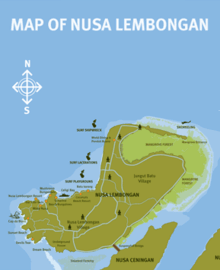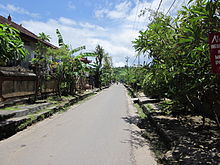- Nusa Lembongan
-
Nusa Lembongan is an island located southeast of Bali at 8°40.906′S 115°27.067′E / 8.681767°S 115.451117°ECoordinates: 8°40.906′S 115°27.067′E / 8.681767°S 115.451117°E, Indonesia forming part of the Lesser Sunda Islands. Nusa Lembongan is the most famous of the three islands.[1]
Contents
Administration
Administratively, the island is part of a subdistrict of Klungkung regency. Nusa Lembongan is one of three small offshore islands which make up a sub-regency of Klungkung, the others being: Nusa Penida and Nusa Ceningan.[2] Nusa Lembongan is the only one of the three islands within the sub-regency to have any tourist infrastructure and is a popular side destination for visitors to Bali.
Geography
Nusa Lembongan is approximately 8 square kilometres in size with a permanent population estimated at 5,000.[3] Twelve kilometres of the Badung Strait separates Nusa Lembongan from Bali. The island is surrounded by coral reefs with white sand beaches and low limestone cliffs. Nusa Lembongan is separated from Nusa Cenignan by a shallow estuarine channel which is difficult to navigate at low tide. There is a suspension bridge linking Nusa Lembongan and Nusa Ceningan and this takes foot and motorbike traffic only. There are no permanent waterways on Nusa Lembongan.
There are three main villages on the island. Jungut Batu and Mushroom Bay are the centres of the tourist-based industry and activities on the island[4] whilst much of the permanent local population resides in Lembongan Village.
To the east, the Lombok Strait separates the three islands from Lombok, and marks the biogeographical division between the fauna of the Indomalayan ecozone and the distinctly different fauna of Australasia. The transition is known as the Wallace Line, named after Alfred Russel Wallace, who first proposed a transition zone between these two major biomes.
The north-eastern side of the island is flanked by a relatively large area of mangroves totalling some 212 hectares.[5]
Local Economy
The economy is largely tourism-based and Nusa Lembongan is the only one of the three neighbouring islands to have any significant tourism-based infrastructure. There is also subsistence agriculture and fishing[6] on the island and a seaweed farming micro-industry.[7]
Conservation Issues
Marine conservation is considered extremely important to sustaining future levels of tourism on the island and in February 2009, a local NGO from Nusa Lembongan, facilitated by The Nature Conservancy Coral Triangle Center, opened a community centre on Nusa Lembongan. The waters around Nusa Lembongan and Nusa Penida have at least 247 species of coral and 562 species of reef fish.[8]
Other conservation initiatives include a release programme of critically endangered Olive Ridley Turtles from Sunset Beach on the south western coast.[9][10]
References
- ^ http://www.thejakartapost.com/news/2011/05/30/administration-improve-access-nusa-penida.html
- ^ Government Office of the Regency of Klungkung, http://www.klungkungkab.go.id/main.php?go=profil
- ^ All about Nusa Lembongan, http://nusalembongannews.blogspot.com/2009/05/news-and-rambles-from-nusa-lembongan.html
- ^ About Nusa Lembongan, http://www.nusalembonganproperty.com/about_nusa_lembongan.htm
- ^ Survey and Condition of the Mangrove Forest at Nusa Lembongan and Nusa Ceningan, http://ejournal.unud.ac.id/abstrak/jenis%20tumbuhan.pdf
- ^ The Jakarta Post, Feb 24th 2009, http://www.thejakartapost.com/news/2009/02/24/residents-lack-tools-monitor-destructive-fishing.html
- ^ United Nations Fisheries and Aquaculture Department, Production of Seaweed in Indonesia, http://www.fao.org/docrep/field/009/ag155e/AG155E05.htm#ref4.5
- ^ The Nature Conservancy Coral Triangle Center in Nusa Lembongan, News February 21st 2009, http://www.coraltrianglecenter.org/
- ^ News from Nusa Lembongan, http://nusalembongannews.blogspot.com/2009/07/visitors-to-nusa-lembongan-doing-their.html
- ^ The Jakarta Post, July 16th 2009, http://www.thejakartapost.com/news/2009/07/16/baby-sea-turtles-head-a-big-adventure.html
External links
Categories:- Subdistricts of Indonesia
- Islands of Bali
Wikimedia Foundation. 2010.




